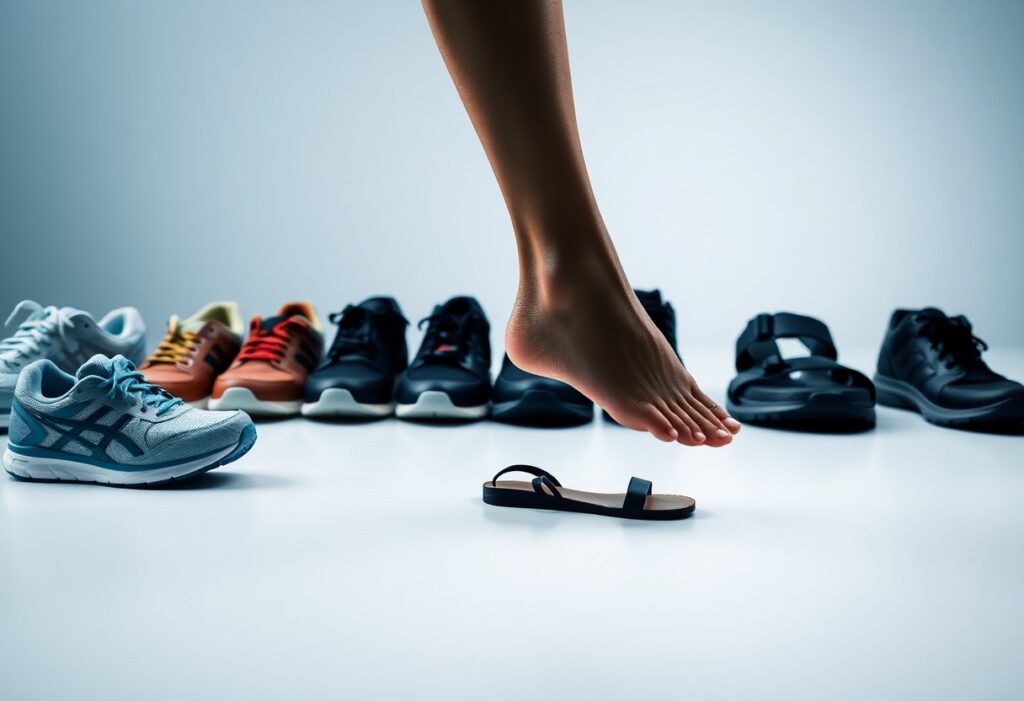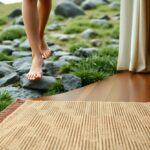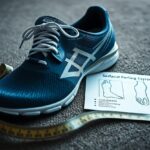
As you move about your daily life, the choice of footwear can have a profound impact on your foot health. Many people mistakenly believe that shoes with extra cushioning and support are the best solutions for foot discomfort. However, traditional shoe designs often exacerbate existing problems rather than alleviate them. Dr. Alissa Kuizinas, a renowned podiatrist from Massachusetts, strongly advocates for the use of barefoot shoes or minimalistic footwear. She suggests that these types of shoes can promote stronger, healthier feet. By opting for footwear that encourages natural foot movement, you can significantly reduce the risk of developing foot issues and improve your overall foot wellness.
Recognizing the Hidden Dangers of Conventional Footwear
While conventional shoes might provide temporary relief from foot pain, they often exacerbate existing issues and introduce new problems, as highlighted by Dr. Alissa Kuizinas. She points out that the $133 billion shoe industry tends to prioritize aesthetics and profit margins over genuine foot health, resulting in designs that can constrict and weaken the foot structure over time. This dependence on traditional footwear creates a cycle of reliance that can ultimately deteriorate your foot health, making it imperative to reconsider the types of shoes we choose.
Examining the Shoe Industry’s Misguided Focus on Foot Health
At the heart of the issue is the shoe industry’s flawed perspective on foot health, which often emphasizes the addition of excessive cushioning, support, and rigid constructions without addressing the actual causes of discomfort. This approach fosters a dependence on conventional shoes that may ultimately harm your foot health over time, leading to complications that could have been easily avoided with more thoughtful footwear choices.
Uncovering the Issues with Traditional Shoe Designs
Traditional shoe designs often include narrow toe boxes, stiff soles, and excessive cushioning that can impair natural foot movement, resulting in weak and dysfunctional foot mechanics. Dr. Kuizinas emphasizes that footwear should protect your feet from external elements while allowing for natural movements. A well-constructed shoe should prioritize natural foot function and incorporate minimalist features, such as spacious toe boxes, flexible flat soles, and minimal cushioning to better support foot health.
Transitioning to barefoot shoes or minimalistic footwear can actively enhance your foot strength and improve your overall foot well-being. Dr. Kuizinas promotes a philosophy of wearing as little shoe as possible to allow your feet to function naturally and move freely, which is essential for maintaining optimal foot mechanics.
The Essential Benefits of Allowing Natural Foot Movement
Footwear that limits your foot's ability to move freely can result in a range of foot issues and discomfort. It's crucial to assess how your shoe choices influence your overall foot health and comfort levels daily.
Evaluating How Shoes Affect Foot Mobility and Function
To understand the impact of shoes on your foot's mobility, it's vital to analyze the specific design elements and features of your footwear. Traditional shoes often incorporate cushioning and support systems that can inadvertently hinder natural foot movements, leading to weak and dysfunctional feet over time. Such restrictions prevent your feet from developing the necessary strength and flexibility they require for optimal function.
Reaping the Benefits of Natural Foot Mobility
The benefits of allowing your feet to move naturally are extensive, as strong feet are integral to overall foot health. By choosing minimalistic shoes or barefoot options, you empower your feet to operate as intended, fostering strength and resilience. Natural movement is essential for developing strong feet. When confined by conventional footwear, you risk an array of foot problems and discomfort. On the other hand, embracing minimalistic shoes or barefoot alternatives can significantly enhance your foot health by enabling natural movement and promoting strength development. By selecting appropriate footwear, you can reduce the risk of foot-related issues and improve your overall foot wellness.
Understanding the Importance of Functional Footwear
Gaining a comprehensive understanding of functional footwear is vital, as these shoes prioritize both foot health and the ability to move naturally. Functional shoes are specifically engineered to allow your feet to function as they should, removing the necessity for excessive support or confinement.
Defining Functional Footwear and Its Key Features
Through thorough research and experimentation with various shoe styles, you will find that functional footwear exhibits unique characteristics. These include a wide toe box, flat and flexible soles, and minimal cushioning and support. Such features allow your feet to move freely and naturally, promoting stronger and more capable foot mechanics.
The Health Benefits of Wearing Functional Footwear
Wearing functional shoes presents numerous advantages, including enhanced foot strength, a reduced risk of injury, and improved overall foot health. These shoes allow your feet to function as intended, paving the way for stronger feet and better balance in your daily activities. Essentially, functional footwear is designed to support your feet without imposing unnecessary restrictions, enabling natural movement and flexibility. This design philosophy promotes optimal foot health while minimizing the risk of developing foot ailments. By selecting functional shoes like barefoot shoes or minimalistic options, you actively support healthy foot function and reduce the likelihood of foot pain and injuries. Although transitioning to functional footwear may require time and gradual adjustment, the long-term benefits for your foot health are priceless.
Recognizing Key Features of Optimal Functional Footwear
To achieve the best possible foot health, it’s essential to select shoes equipped with specific characteristics. The key attributes to consider when choosing functional footwear include:
- Wide toe box
- Flat and flexible soles
- Minimal cushioning and support
Being aware of these critical features will greatly assist you in selecting footwear that promotes healthy foot function and support.
The Significance of Wide Toe Boxes and Flexible Soles
A fundamental characteristic of functional shoes is a wide toe box, which allows your toes to spread naturally. This thoughtful design helps to prevent toe jamming and other discomfort-related issues that could lead to chronic foot pain over time.
Understanding the Need for Minimal Cushioning and Support
Alongside a wide toe box, functional footwear should also possess minimal cushioning and support. This design element enables your feet to move naturally, strengthening foot muscles and decreasing the risk of foot issues. It's essential to emphasize that minimalistic footwear, including barefoot shoes, can greatly enhance your foot health by allowing your feet to function freely. By selecting shoes with minimal cushioning and support, you can boost muscle strength in your feet and reduce the likelihood of injuries. This strategic approach not only improves your overall foot health but also minimizes the chances of experiencing chronic pain. Therefore, prioritize shoes that permit your feet to move naturally and avoid excessive cushioning or support.
Transitioning to Functional Footwear: A Step-by-Step Guide
Having recognized the importance of functional footwear, you are now ready to begin your transition. Contrary to the widespread belief that added cushioning and support equates to better comfort, it is advisable to choose minimalistic shoes or barefoot footwear that support your feet's natural functioning.
Practical Tips for a Smooth Transition to Functional Footwear
If you have any reservations, start incorporating functional shoes into your daily routine with these practical suggestions:
- Begin with short walks and gradually increase the distance
- Select shoes with a wide toe box and flat soles
- Choose minimal cushioning and support
The key is to allow your feet ample time to adapt to the new footwear while simultaneously strengthening the muscles in your feet.
Highlighting the Importance of Patience During the Transition
Transitioning to functional footwear requires patience and a gradual approach. Overly minimalist shoes can lead to discomfort and pain if your feet are not accustomed to them. Starting slowly is essential, allowing your feet to acclimate to the new footwear.
Footwear options like barefoot shoes or minimalistic shoes can significantly improve your foot health, but it’s crucial to introduce them gradually. Overuse or improper sizing can lead to injuries or persistent discomfort. The ultimate aim is to strengthen your foot muscles while enhancing your overall foot health, so take your time and avoid rushing the process. The rewards will be substantial; expect to experience improved balance, reduced pain, and stronger feet.
Building Strong and Functional Feet for Life
Even in a culture where shoes with excessive cushioning and support dominate, you can cultivate strong and functional feet by choosing the right footwear.
The Connection Between Foot Strength and Overall Wellness
Alongside other health factors, foot strength plays a critical role in your general well-being, affecting your balance, posture, and movement capabilities.
How Functional Footwear Supports Strong Foot Development
Functionally designed shoes that feature a wide toe box, flat and flexible soles, and minimal cushioning are essential for developing strong feet, as they facilitate natural movement. Indeed, wearing functional shoes or barefoot footwear can significantly contribute to building stronger foot muscles and enhancing your overall foot health. By allowing your feet the freedom to move and function naturally, you can reduce the risk of foot problems and optimize your balance and stability. As you transition to minimalistic shoes, you can expect to notice improvements in your walking technique and an overall enhancement in your sense of well-being.
By taking proactive steps towards your foot health, you can select footwear that aligns with your feet’s natural functions instead of hindering them. Choosing barefoot shoes or minimalistic options that support your feet’s natural movement will facilitate strength development over time. In doing so, you’ll enjoy increased stability and comfort during various activities, allowing your feet the opportunity to grow strong and capable. Start your journey by searching for shoes that feature a wide toe box, flat and flexible soles, and minimal cushioning and support, and remember to exercise patience as you transition to a more natural walking style.
The Article A Podiatrist’s Guide to How Shoes Affect Your Foot Health appeared first on My Shoes Finder
The Article How Shoes Impact Your Foot Health: A Podiatrist’s Insights Was Found On https://limitsofstrategy.com






